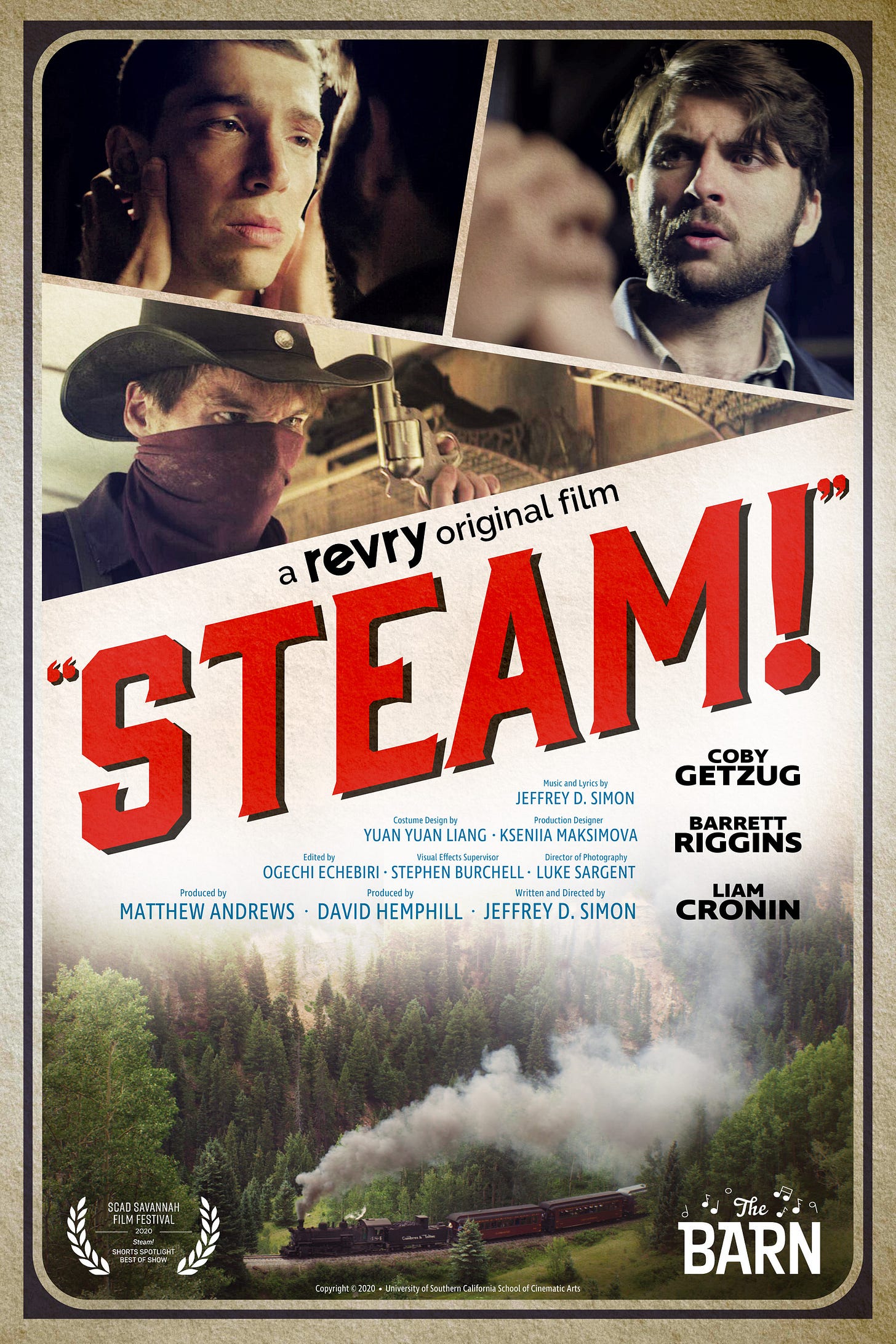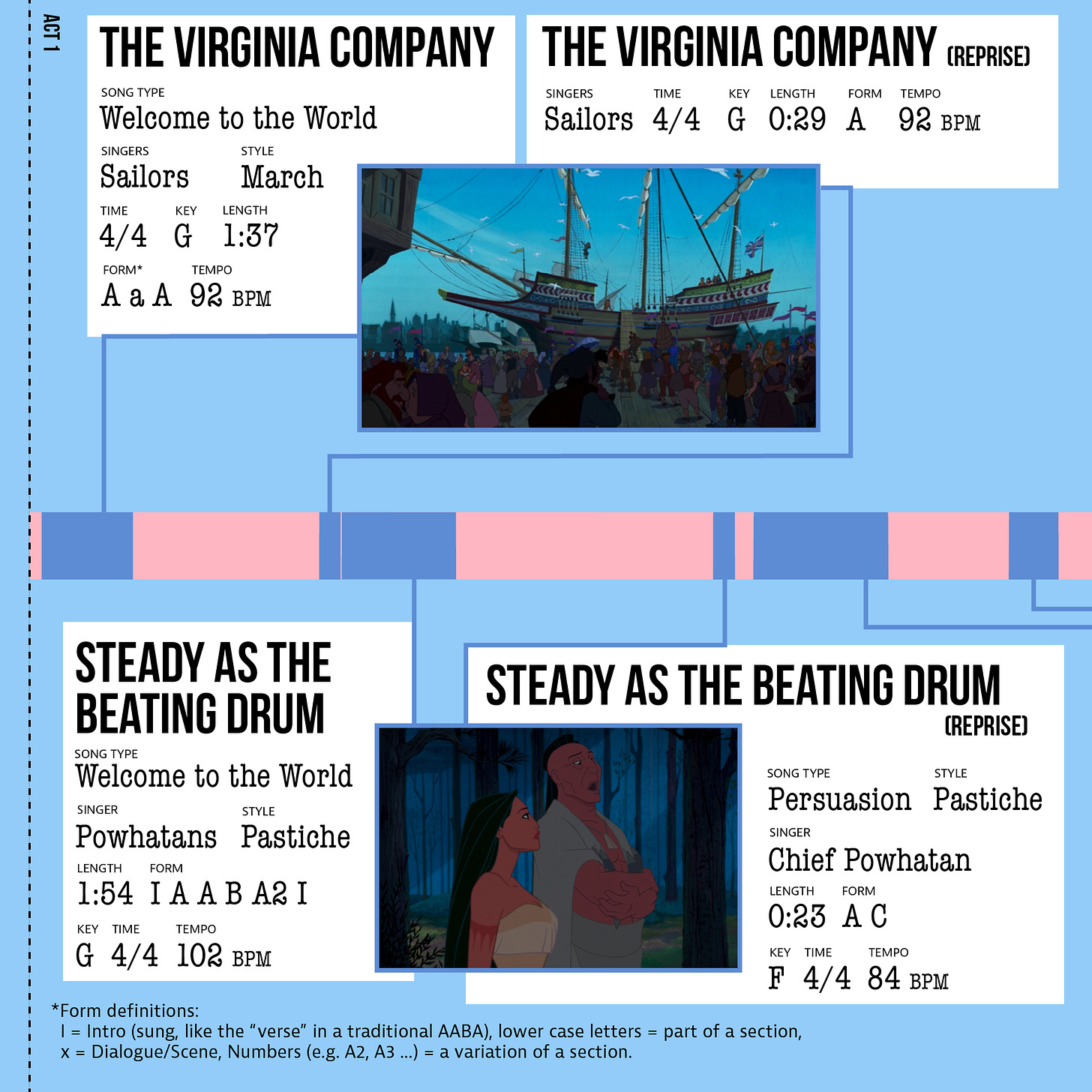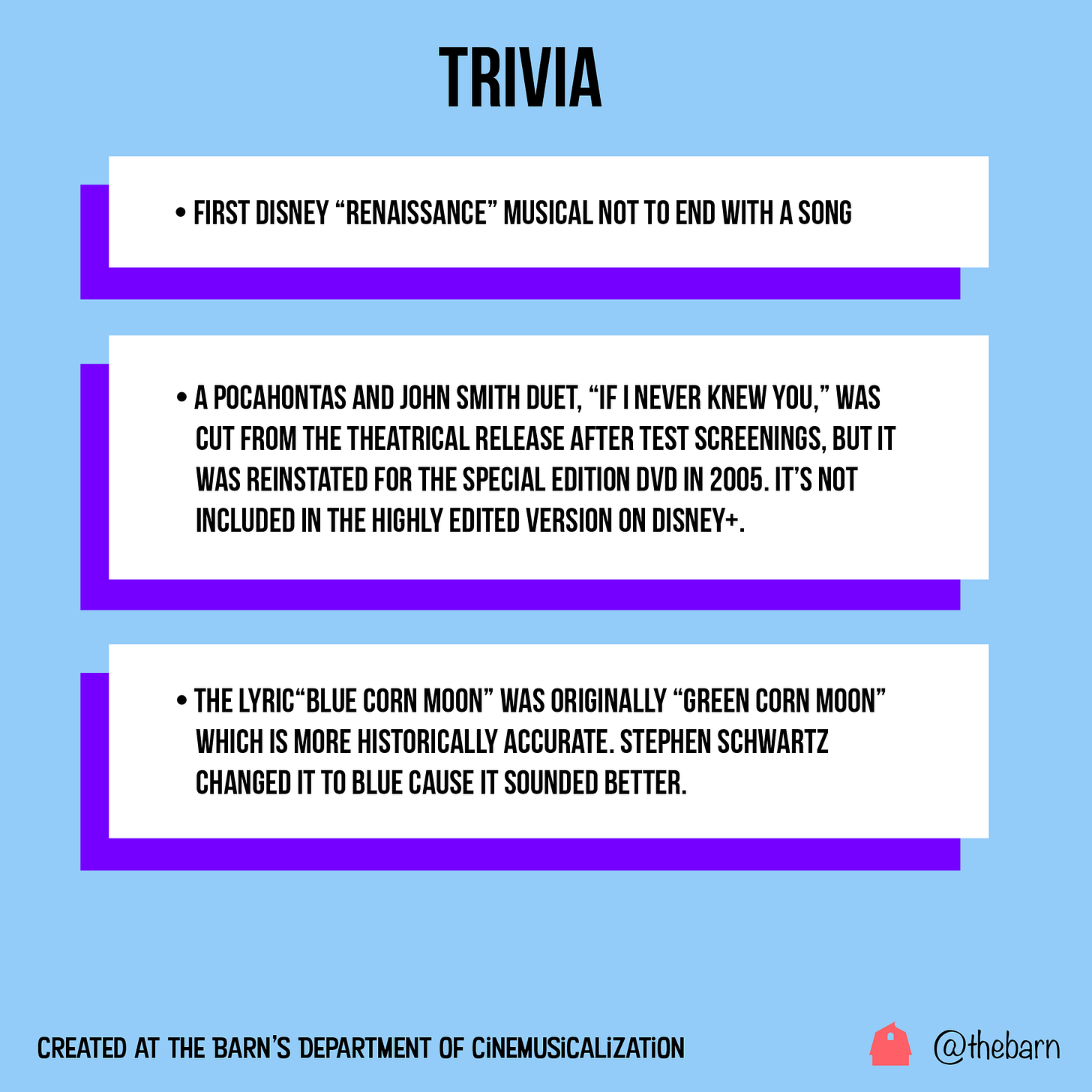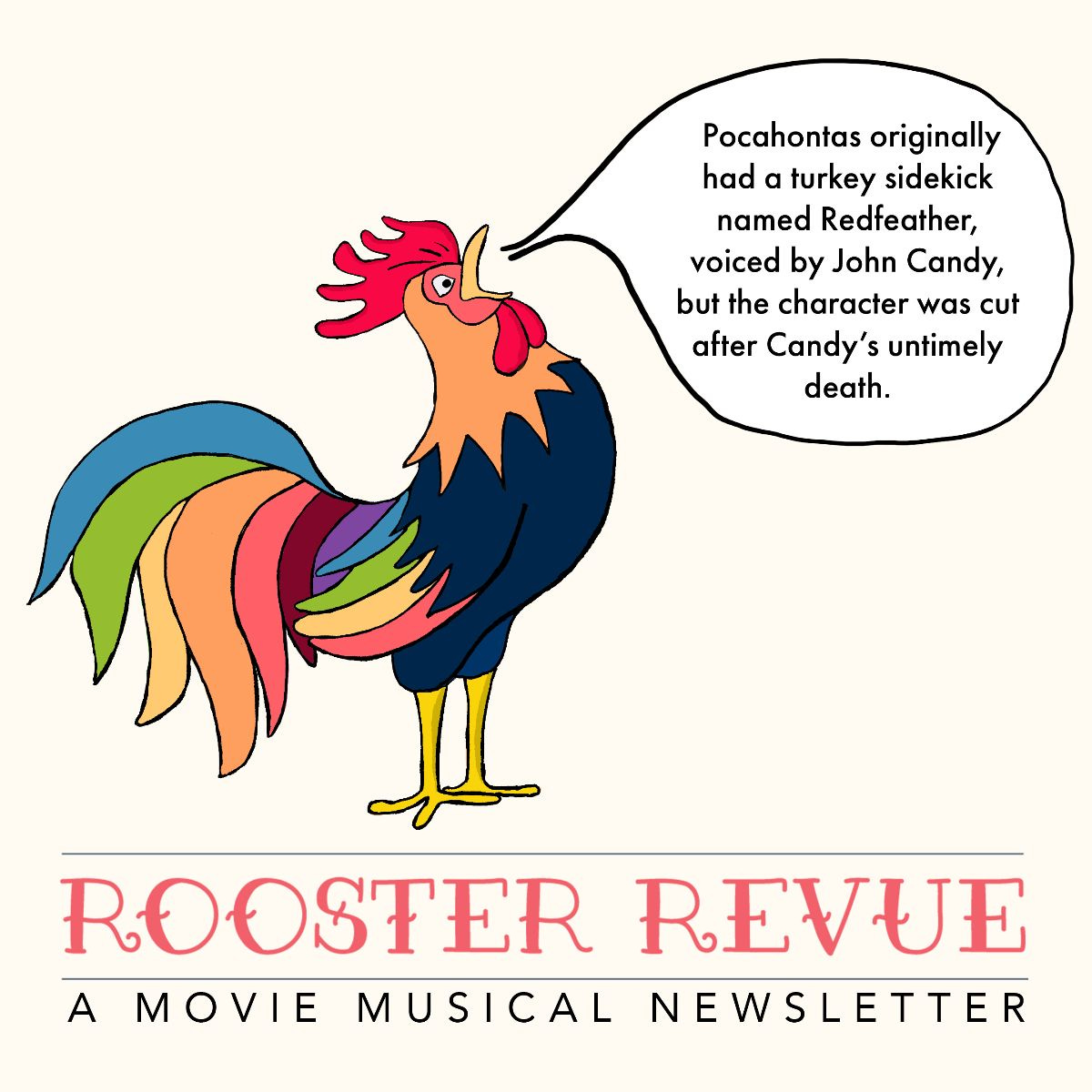Rooster Revue #20 • Just Around the Riverbend
A breakdown of "Pocahontas." Plus it's our one year anniversary!
Issue 20
It’s the official anniversary of the Rooster Revue. Thank you to everyone who has ever read an issue. To celebrate, we have a new Disney Animated Musical breakdown of Pocahontas!
IN CASE YOU MISSED IT
Our musical short film STEAM! is now playing on demand on Revry.tv or via their apps on your favorite devices.
The soundtrack is available everywhere you listen to music including Apple Music and Spotify.
Read reviews on Broadway World, OUT and Queerty.
• Cyrano, the musical adaptation of the 1897, is in theaters everywhere this Friday. Starring Peter Dinklage and directed by Joe Wright (Hanna, Darkest Hour) [Trailer]
• West Side Story coming to Disney+ & HBO Max on March 2 [Deadline]
• 13 coming to Netflix in November [Broadway World]
• Hulu Orders Up Here Musical Series From Steven Levenson, Danielle Sanchez-Witzel, Thomas Kail & Kristen Anderson-Lopez and Robert Lopez [Deadline]
• Megan Thee Stallion, Nathan Lane Set for A24 Musical Comedy F*cking Identical Twins [Hollywood Reporter]
• And finally here are some Tick... Tick... Boom! bloopers because... why not? [Twitter]
Pocahontas is a problematic movie with some really beautiful songs. There’s plenty of good material out there discussing its problems. We’re here to take an objective look at how the music serves the story.
The Virginia Company
Similar to “Fathoms Below” from The Little Mermaid, this is a “Welcome to the World” song from the point of view of the film's antagonistic forces. It sets up how they think of the “New World,” a place you can “pluck gold off a tree”—and that it’s promised to them by virtue of “Glory and God.”
Where this song succeeds is in injecting a sentiment of doubt in the lyrics with the line “or so we have been told by the Virginia Company.” Already we are sensing that maybe this company should not be trusted.
Something interesting about the song is there are no mouths moving, so while it sounds like it’s a chant from a group of men, presumably the shipmates, no one is ever seen visibly singing. That is until the reprise a few minutes later.
The Virginia Company (Reprise)
This reprise relishes in the killing of Indians in the name of The Virginia Company.
This song bookends our introduction to the story’s White counterparts. It spends a good five minutes with them before we enter the world of Pocahontas which makes sense considering how large a part this crew will play in the film, but very little is done to make us like these men; aside from John Smith and his act of selfless heroism.
With no break whatsoever, this song transitions into…
Steady As The Beating Drum
This is another “Welcome to the World” song, just a different world. It’s about living in harmony with the land and relying on mother nature to survive. Unlike the previous song, which is about wanting something to make their lives better, this is about appreciating what they have and not wanting anything to change.
According to Stephen Schwartz, the lyrics are Algonkian, the language of the Powhatans, and were extensively researched, yet he does not remember their meaning or context. “They may refer to the content of the song (about continuity), or they may just be a chant I cribbed from another Algonkian song.”
Similarly, no one is seen singing this song. Perhaps in both this and “The Virginia Company” the songs are internal musical projections, until they are not.
Steady As The Beating Drum (Reprise)
By the time we come back to song, we learn the Powhatan people are not without conflict, as their men have just returned from war with another tribe. We learn that Pocahontas is having a strange recurring dream, and finally that Kocoum has asked Pocahontas’ hand in marriage.
Having doubts about marrying Kocoum, this reprise functions as a Persuasion song from her father. He must know that Pocahontas relates to the river, and describes how the river always chooses the smoothest course, and that she should too.
Just Around the Riverbend
This “I Want” song is very much a response to her father’s river metaphor, and she basically takes his hypothesis and rips it to pieces. The thing about rivers that Pocahontas loves is that you never know what’s waiting “just around the riverbend,” and it’s her belief that something will be “coming for [her].”
Her father’s argument is truly dismantled when she comes across a fork in the river. River’s are indecisive, too. She’s forced to choose between a path of safety with Kocoum and the unknown path full of turns and rocks and excitement.
Listen With Your Heart, Pt. 1
Still unsure of her path, Pocahontas comes to Grandmother Willow for help. In this “Mentor Song,” Grandmother Willow teaches Pocahontas that if you listen with your heart, you can understand the spirits of the earth, water and sky.
This song is setting up the notion that you can overcome language barriers between the human realm and the spirit realm, if you listen with your heart. This idea is carried further to overcome literal language barriers later in the story.
Musically, this song has a modal quality that appears throughout the score that alludes to Native American music/pastiche.
Worth noting here that this movie has already packed four different songs and two short reprises within the first 20 minutes of this movie. Every other Disney movie we’ve looked at so far is at two songs by this point—and we still haven’t had an inciting incident.
Mine, Mine, Mine
“Mine, Mine, Mine” is one of our favorite songs in the film. Not only does it have a double meaning, it’s also two songs in one, serving as a rousing “Villain Song” for Governor Ratcliffe, and a “Celebration Song” for John Smith who feels this is the land he’s been searching for all his life.
John Smith literally interjects in the middle of what would be a very structured Verse/Chorus song that does what Menken often does, which is to slowly modulate up ½ steps as the exciting builds, by singing a completely new melody in Eb, a minor third down from F#, before returning to the original structure and finishing the song off with Ratcliffe in G, where we expected the song to go. It’s interesting to see Menken almost commenting on his past work by setting the expectations (like he did in "Be Our Guest," "Prince Ali," "Something There," "The Mob Song," and others …) and then completely shifting directions in the middle.
Listen With Your Heart, Pt. 2
Grandmother Willow sings this reprise off screen. Prompted by Pocahontas and John Smith touching hands, the song enables them to overcome their language barriers and completely understand each other (it's ridiculous).
Colors of the Wind
Which brings us to the “Love Song” (and the Academy Award winning song) of the film. This is actually a “Teaching Song” about how Pocahontas interacts with the world that also happens to serve as a “Love Song.” John Smith is falling in love with her way of life.
From an animation perspective this song does some incredibly unique and beautiful things in their attempt to visualize the wind. The second half of the song is just a psychedelic visual feast, as if the world has been colored by the wind (or by Pocahontas) and John Smith is seeing this new world for the first time.
On the phrase "blue corn moon”:
“In preparation for doing the lyrics to POCAHONTAS, I read a lot of Native American poetry. One of the phrases I came across, in a love poem, was: "I will come to you in the moon of green corn." The phrase stuck in my head, but I didn't think the lyric: "Have you ever heard the wolf cry to the green corn moon" really worked, because of the association of the moon and green cheese, plus the "ee" sound in it, etc. So I changed it to blue corn moon, which I thought had a nice resonance to it. Even though it's not authentic, and actually implies Southwestern tribes rather than the Northeastern Algonkians of Pocahontas, I used it in the lyric and it obviously served me very well.” —Stephen Schwartz
Listen With Your Heart, Pt. 3
This reprise is so short it doesn’t make the soundtrack. It’s the first phrase of an AABA stanza. It’s simply a way of showing that John Smith has come so far that now he too can see Grandmother Willow.
Aside from this small 10 second number, we are now in the longest stretch of no songs in the film—over 21 minutes of no singing. Remember those 4 songs in 20 minutes? We miss those.
There actually were 2 songs cut in this space. One was called “In the Middle of the River” which you can watch an animatic of on Disney+. The other was called “If I Never Knew You,” and was cut at after test screenings from the theatrical release because they were losing kids' attention. It was reinstated for the special edition DVD in 2005, but doesn’t exist in the highly edited current version on Disney+. It can now only be found on YouTube.
Savages. Pt 1
After learning about John Smith’s capture, Governor Ratcliffe rallies his men for battle with this stirring war anthem. They suit up and “sound the drums of war.” The second half of the song is nearly identical, but sung by the Powhatan people. Similar in form, function and tempo to “The Mob Song” from Beauty and the Beast.
Lyrical changes were made for the Disney+ version to make the song more “politically correct.”
Savages, Pt 2
The second part of the song leads us right into the climax of the movie, which is very effective and the first time we see a musical climax in the Disney Animated canon. Previously the songs stop in service of the action.
When the song comes back, we now have a third side to the song: Pocahontas, the voice of love. Having realized her path, she too is moving towards the showdown. What really works is that Pocahontas is not singing the melody of “Savages,” she is singing the melody of “Steady as the Beating Drum,” which indicates she has completed her arc and has found her voice, found her destiny, found her place among her people.
The Finale
Nope. Nevermind. This is the first Disney animated musical that doesn’t end with a reprise.
Help us reach more Movie Musical lovers and forward this email to anybody you think may love it! This is our first issue and we're excited to build our audience.
Was this forwarded to you? Subscribe Here.
ABOUT THIS EMAIL
"Rooster Revue" is edited by Matt Andrews and Jeffrey Simon with contributions from the entire team at The Barn. Read past issues in the archive.

















